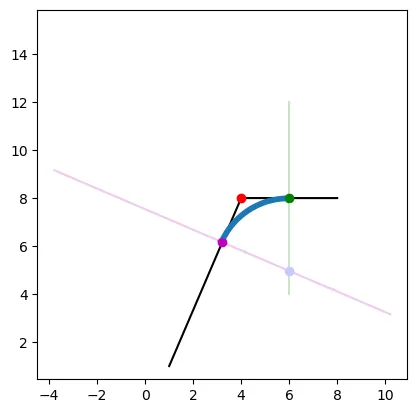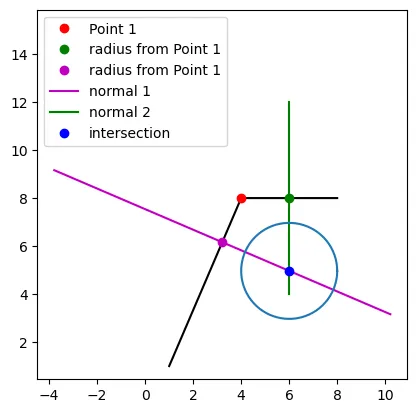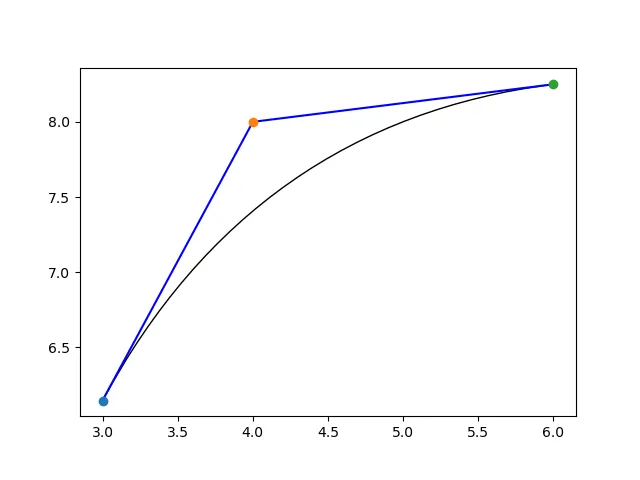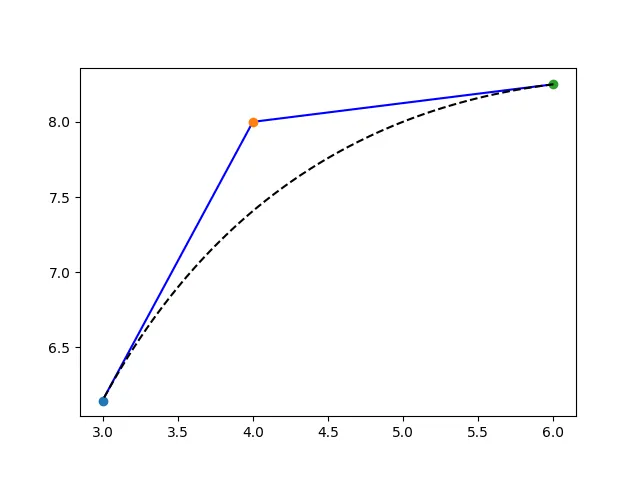我正在尝试在两个点之间绘制一个由n步组成的弧,以便我可以将2D形状倒角。这张图片展示了我的想法(蓝色的弧线)和我尝试实现它的方法:
非常感谢!
- 根据半径从目标点(红点)移动
- 获取这些线的法线
- 获取法线的交点以找到圆的中心
- 从圆心处绘制弧线
import matplotlib.pyplot as plt
import numpy as np
#https://stackoverflow.com/questions/51223685/create-circle-tangent-to-two-lines-with-radius-r-geometry
def travel(dx, x1, y1, x2, y2):
a = {"x": x2 - x1, "y": y2 - y1}
mag = np.sqrt(a["x"]*a["x"] + a["y"]*a["y"])
if (mag == 0):
a["x"] = a["y"] = 0;
else:
a["x"] = a["x"]/mag*dx
a["y"] = a["y"]/mag*dx
return [x1 + a["x"], y1 + a["y"]]
def plot_line(line,color="go-",label=""):
plt.plot([p[0] for p in line],
[p[1] for p in line],color,label=label)
def line_intersection(line1, line2):
xdiff = (line1[0][0] - line1[1][0], line2[0][0] - line2[1][0])
ydiff = (line1[0][1] - line1[1][1], line2[0][1] - line2[1][1])
def det(a, b):
return a[0] * b[1] - a[1] * b[0]
div = det(xdiff, ydiff)
if div == 0:
raise Exception('lines do not intersect')
d = (det(*line1), det(*line2))
x = det(d, xdiff) / div
y = det(d, ydiff) / div
return x, y
line_segment1 = [[1,1],[4,8]]
line_segment2 = [[4,8],[8,8]]
line = line_segment1 + line_segment2
plot_line(line,'k-')
radius = 2
l1_x1 = line_segment1[0][0]
l1_y1 = line_segment1[0][1]
l1_x2 = line_segment1[1][0]
l1_y2 = line_segment1[1][1]
new_point1 = travel(radius, l1_x2, l1_y2, l1_x1, l1_y1)
l2_x1 = line_segment2[0][0]
l2_y1 = line_segment2[0][1]
l2_x2 = line_segment2[1][0]
l2_y2 = line_segment2[1][1]
new_point2 = travel(radius, l2_x1, l2_y1, l2_x2, l2_y2)
plt.plot(line_segment1[1][0], line_segment1[1][1],'ro',label="Point 1")
plt.plot(new_point2[0], new_point2[1],'go',label="radius from Point 1")
plt.plot(new_point1[0], new_point1[1],'mo',label="radius from Point 1")
# normal 1
dx = l1_x2 - l1_x1
dy = l1_y2 - l1_y1
normal_line1 = [[new_point1[0]+-dy, new_point1[1]+dx],[new_point1[0]+dy, new_point1[1]+-dx]]
plot_line(normal_line1,'m',label="normal 1")
# normal 2
dx2 = l2_x2 - l2_x1
dy2 = l2_y2 - l2_y1
normal_line2 = [[new_point2[0]+-dy2, new_point2[1]+dx2],[new_point2[0]+dy2, new_point2[1]+-dx2]]
plot_line(normal_line2,'g',label="normal 2")
x, y = line_intersection(normal_line1,normal_line2)
plt.plot(x, y,'bo',label="intersection") #'blue'
theta = np.linspace( 0 , 2 * np.pi , 150 )
a = x + radius * np.cos( theta )
b = y + radius * np.sin( theta )
plt.plot(a, b)
plt.legend()
plt.axis('square')
plt.show()
非常感谢!



